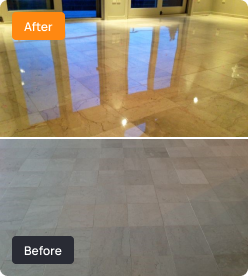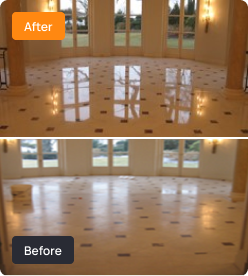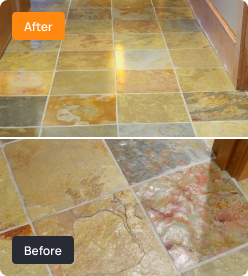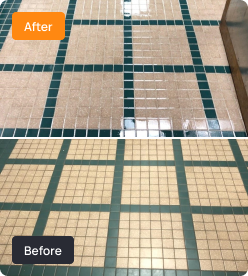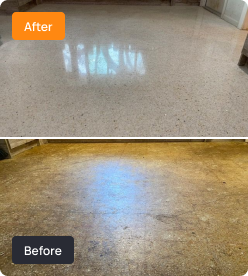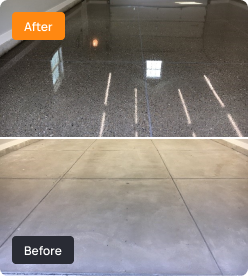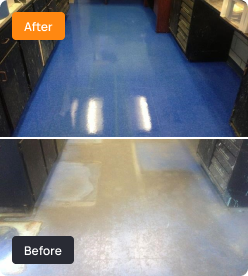The Key To A Good-Looking Stone
Stone surfaces can appear dull and dirty with time, despite your best cleaning efforts, and sometimes perhaps because of them. Stone floors lose their high polish over time. Traffic areas develop at entrances and turn areas, where we see the highest concentration of feet, and the most pivoting. Table and counter tops show light scratches […]


Stone surfaces can appear dull and dirty with time, despite your best cleaning efforts, and sometimes perhaps because of them. Stone floors lose their high polish over time. Traffic areas develop at entrances and turn areas, where we see the highest concentration of feet, and the most pivoting. Table and counter tops show light scratches and dull areas across the surface, as keys are tossed or drinks spilled. This is inevitable with all stone. The good news is it can all be restored. When a ceramic or vinyl floor wears, it must be replaced or resurfaced. A stone floor that has lost its polished can be brought back to life with a little tlc.
Cleaning, and the topic of polish restoration seems to be often confused and misunderstood. The dilemma this presents is quite common. Let me give you an example. Your floor is 3 years old. There are some areas that have very little shine. The area at the front door is dull and scratched. You call three contractors in to give you an estimate of how much it will cost to make your floor look new again.
A knowledgeable craftsman, can provide a number of different services based on what you are seeking to achieve ranging from a factory finish to simply restoring a shine (but not removing scratches).
Your floor, began its life as a rock buried in a mountain or under the ocean. It is then quarried into blocks, cut into slabs, and eventually sliced into tiles. These tiles will still bear cutting marks of the saw which are often visible on the back of your tile before installed (or if you have extras). These marks are then ground out using a series of abrasives getting finer and finer until the surface has been ground, honed and polished to a mirror like finish, having flattened the surface so that light can bounce true off its surface, just like your mirror backing.
When a true craftsman arrives to assist you, he has a number of tools available to him, but which is the most appropriate to your need, will depend on what you seek to accomplish. A craftsman can regrind the floor to restore that factory finish if that is what you seek, or he can simply polish the surface to restore a shine, but leave any large scratches behind. If you want shine that may be fine, but if you want your floor restored and the scratches removed, it is going to take a couple more steps with a series of abrasives to work those scratches out. Have no fear though, in most cases one is talking about the depth of a human hair, and as such the floor can be restored without shortening the floor life, and while maintaining a level surface (assuming the craftsman knows what he is doing).
If offered a topical treatment to restore your shine, be sure to understand how long this surface can be expected to last, to resist the natural wear of foot traffic, and when it does wear, how is it maintained? In many cases a topical must be removed and re-applied, where as a craftsman can address a wear issue on a spot basis saving time and money.
One the finish you want has been achieved you still have some decisions to make which will impact the longevity of your surface. Will you reseal the surface? Unless this surface was a resonated (a practice that is becoming more and more common whereby a polyester resin is vaccummed through the pores of the stone in order to reduce its brittleness making it easier to ship around the world without risk of damage, but also provides a secondary benefit of sealing the stone), sealing is a necessary protection as it prevents spills from penetrating and staining your surface. While not an expensive or difficult process, ask anyone who has had their surface stained and they will tell you it is well worth it to avoid the loss of appearance or the time and money needed to remove a stain after the fact. Stone surface should be sealed every 2 to 3 years. Beware the LONG life promises of many sealer manufacturers, more often than not that claim comes with a series of asterisks on how the surface needs to be protected to achieve that long life, which is surprising when one considers this was supposed to be the protectant step.
Hardening is another offering. A hardener is recommended for use on softer stones such as limestone, marble, or travertine. It is designed to provide a thin protective hard surface to better reduce wear. As a final step it also serves to enhance the gloss appearance, however that is not its intended purpose, simply a requirement to be a lost step application. These material are often overused by janitorial companies in an effort to chase a shine. As with anything too much is not a good thing. But when used for the purpose they were intended to enhance the wear resistance of softer stonefloors, they are a valuable part of your floors protection. If you have a marble or limestone floor it is recommended to harden the floor. This should reduce the frequency for which your floor needs to be re-polished or restored. This may not be in the best interest of the craftsman, but the craftsman that is taking care of his clients best interests will make sure to cover this with you.
When reviewing your craftman’s proposal ask that each process be line itemed out, so you understand what he is proposing, and why it is being proposed. Every service is not right for every floor, but its important that every floor be provided the right service. A hotel floor can be expected to be treated very differently to a residential lobby, or an end table’s surface.
No matter which service you decide to go with, always remember to go with a company you can trust that has the size and ability to stand by their service guarantee. Typically, those that have survived and thrived to expand into multiple markets are able to do so as a result of the loyalty of their clients, which only comes through the consistent provision of quality honest service, and beautiful results.
Call MARBLELIFE at (888) 524-3372 or visit us online to secure your FREE ESTIMATE at www.MARBLELIFE.com or to www.MARBLELIFEPRODUCTS.com to secure the care products appropriate to your surface, and your desire for an easy effective cleaning solution.


